sketchup 2d drawing to 3d
How to Create Your First 3D Model in SketchUp: A Beginner-Friendly Introduction
SketchUp is a 3D modeling software for creating geometric 3D objects such equally architectural models, scale models, interior design items, and functional parts. It's a program that gives you the perfect mix of simplicity and quality: SketchUp is known for its convenient interface and easy learning curve. Upon completion of the exercises in this beginner's guide to SketchUp, y'all will know the essential tips and tricks to create your own models in SketchUp. Then allow's get started and learn the basics of this great 3D modeling software!
This tutorial by All3DP'southward SketchUp good Mich Judelag will help you empathize the basics of this powerful 3D modeling software. He will testify y'all how to build a simple 3D object and how to use basic commands and tools in gild to plough your ideas into the 3rd dimension.
In this tutorial yous will learn the very basics of SketchUp, including:
- How to prepare your workspace and get started
- How to draw basic 2nd shapes (lines, rectangles, circles, arcs)
- How to turn a second shape into a 3D object
- How to motility, push, pull, cut, rotate, calibration, copy and delete objects
Ready, steady, go!
Step 1: Download the Software
To download SketchUp, go to https://www.sketchup.com/download, follow the steps, and fill up in the necessary information.
 SketchUp is bachelor both as a freeware version and a paid version with additional functionality, SketchUp Pro. Basically, both versions are the same when information technology comes to basic commands and tools for modeling.
SketchUp is bachelor both as a freeware version and a paid version with additional functionality, SketchUp Pro. Basically, both versions are the same when information technology comes to basic commands and tools for modeling.
SketchUp Free is ideal for beginners, while SketchUp Pro is for advanced users. The former provides all the commands y'all tin employ for 3D modeling, and the latter provides additional functions like printing in scale or exporting/importing to/from CAD software.
Stride 2: Fix the Workspace
SketchUp allows y'all to select the workspace yous want to employ from a window that appears when you lot open the application. The window shows three tabs: Larn, License, and Template. The Template tab displays a listing of unlike presets to select from. They depend on the type of model you lot will be doing.
The presets/templates vary in backgrounds and edge styles – which just affects the visual aspect of your model (i.e. background color and line thickness), blazon of model to be done (i.eastward. landscaping, interiors etc.) and measurement systems (Imperial or Metric). I recommend that y'all explore these templates, but for now, allow us use the Uncomplicated Template – Meters.
Click on the template and then on the button Start using SketchUp on the lower right side of the window. I recommend you to check the box on the lower left side that says Always bear witness on startup, as this will enable you to select any template every time you open the application.
Step 3: View the Most Important Tools
SketchUp has a lot of commands and tools that yous can select from. On your first SketchUp workspace, you will run into default toolbars on the upper part of your screen. Now click on View > Toolbars.
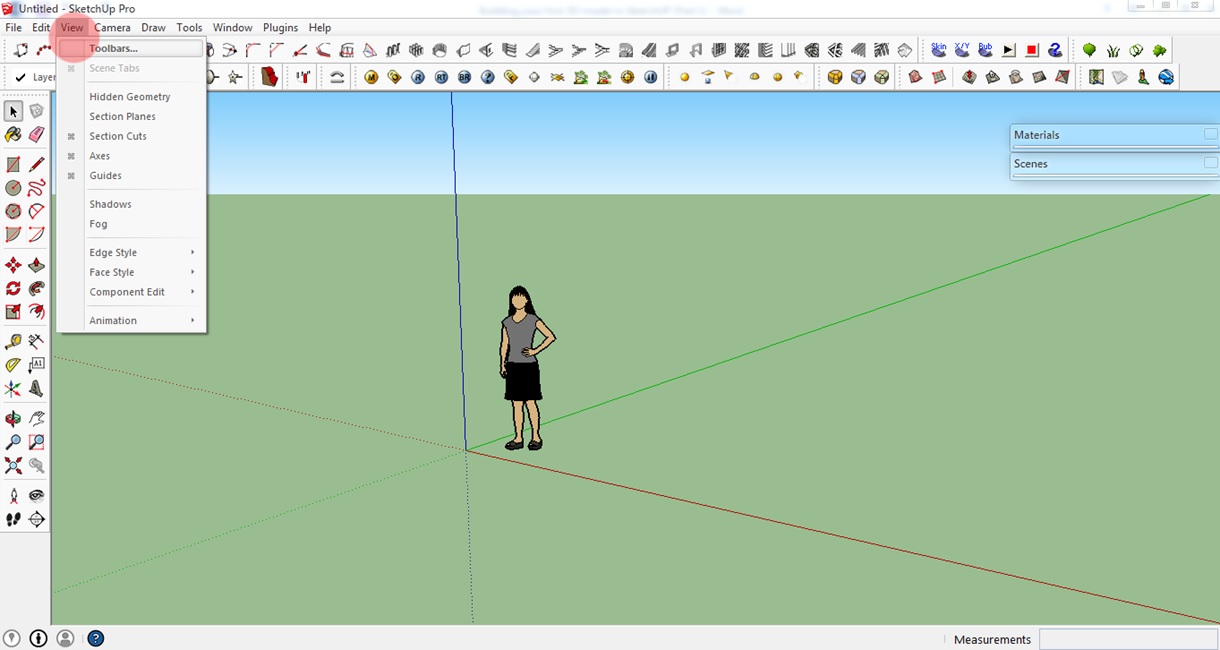
A window will appear with a list of toolbars. For this tutorial, we will use the Large Tool Ready. This toolbar contains nigh of the tools you need to build a 3D model. Bank check the Large Tool Set. I recommend you uncheck the other toolbars to avoid confusion.
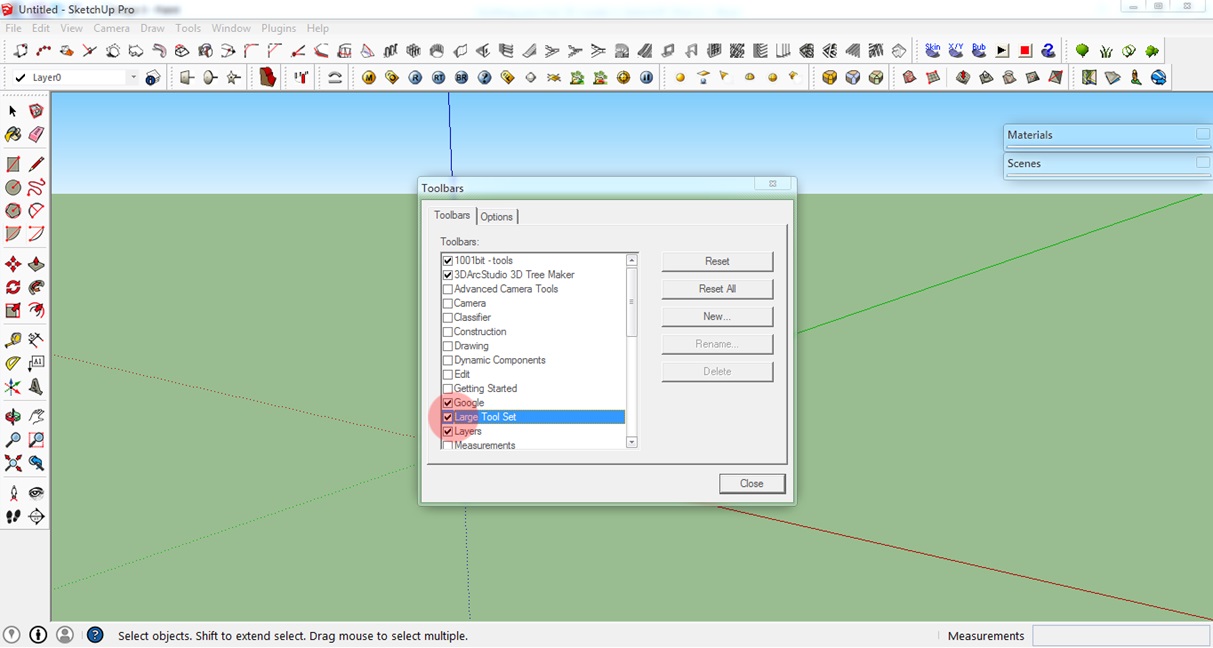
Stride 4: The Axes
SketchUp utilizes the Red, Light-green, and Blue axes in the workspace similar any other 3D software. This allows you lot to view your work from different angles.
As well, SketchUp has a snapping feature that helps you align your lines or models along the different axes.
Now that we have our toolbar fix and see the three-dimensional space with its three axes in front of us, let'southward start creating our first 2d shapes.
Step five: Basic 2D Cartoon – Lines, Rectangles, Circles
To get started, let's describe Lines, Rectangles, and Circles. These are the fundaments of our (future) 3D models.

Cartoon a line:
ane. To draw a line, first click the Pencil symbol on the toolbar or just press L on your keyboard
2. Click anywhere on your screen to assign the first point
3. Drag the mouse to the desired location of the second point and click
4. To specify the length (in this case I entered 5), simply type the value correct afterward Step 2 and press Enter
As you accept probably already noticed, you can align whatsoever line to the Scarlet, Green, or Blue axis of the workspace.
Cartoon rectangles/squares:
ane. To draw a rectangle/square, first, click the Rectangle icon on the left beside the pencil symbol or simply press R on your keyboard
ii. Click the desired location to assign the first corner of your rectangle/square
iii. Elevate the mouse to the desired location for the reverse corner and click
Y'all tin can also enter the length and width of your rectangle/square: enter the values after Step ii and hit Enter on your keyboard. This part is a bit tricky. The first value you enter corresponds to the length/width forth the Crimson axis and the second value corresponds to the length/width along the Green centrality. Enter the values like this: 4, 4, Enter.
Drawing circles:
i. To draw a Circle, outset click the icon below the rectangle icon or simply press C on your keyboard
2. Click the desired point to assign the midpoint of your circle
iii. Drag the cursor anywhere on the screen to make the circle and and then click
4. To specify the radius (i.e. radius = two), simply enter the value right after Stride two and press Enter
Footstep vi: Movement Controls
Allow'south learn how to change our view with the basic movement tools of Pan and Orbit.
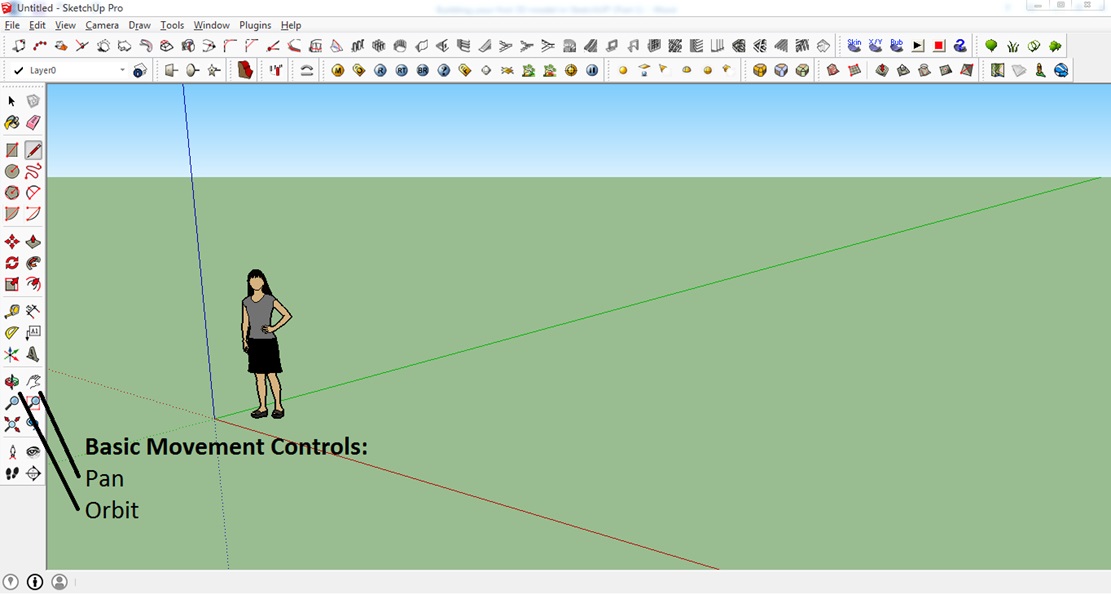
Pan:
i. To utilize Pan, click the icon or simply press H on your keyboard
2. Click to set the origin, concur the mouse button and only drag. This volition allow yous to motion your view
Orbit:
one. To utilize Orbit, click the icon on the toolbar or simply press O on your keyboard
2. Click anywhere, hold and drag to rotate the whole view
three. Y'all can also use the mouse wheel to Orbit
Pace 7: Existence on the Safe Side – Disengage and Saving
If y'all made a error simply click on Edit > Undo and you will be taken back to your previous step. Y'all can likewise press Alt + Backspace to attain this.
In gild non to lose your progress, make sure to relieve your file from time to time. To do this, click File > Save or only press Ctrl + Due south on your keyboard. Enter the filename and select the directory you want your file to be stored in.
Step 8: Making Your Commencement 3D Object
We've already created second shapes. Let's plow them into 3D objects!
one. Beginning, zoom in on i of your 2D shapes past using your mouse wheel button
2. Click the Push button/Pull icon on the toolbar or simply press P on your keyboard
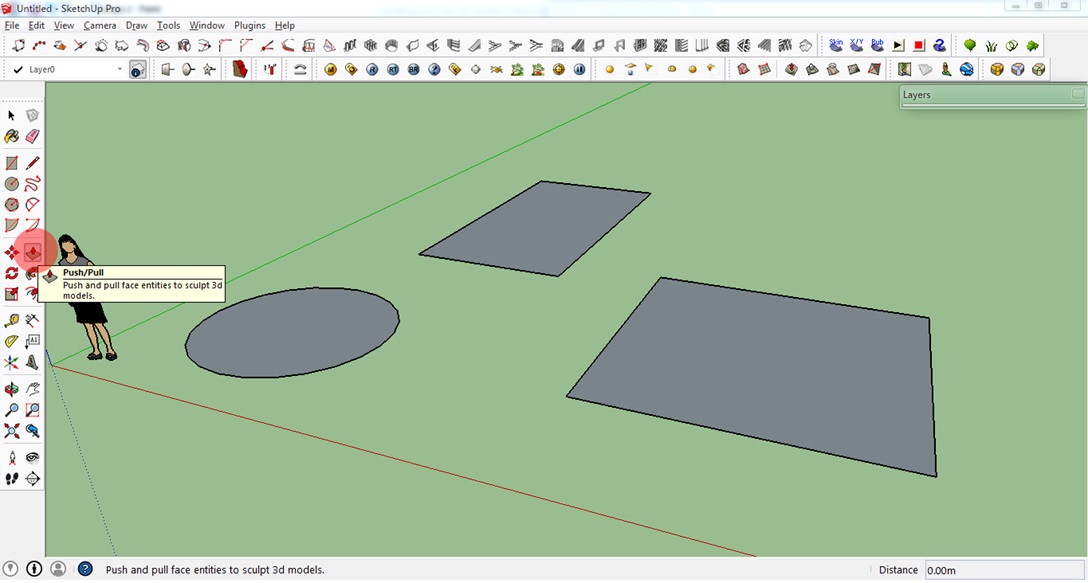
three. Hover your mouse cursor over the plane of the circle
four. When you lot meet the airplane is highlighted (i.e., when the aeroplane shows a dotted texture on it), click on it and simply elevate it upwards. Click the left mouse button once more to set the height of your cylinder, cube or cuboid. Or type the height after the commencement click
Yous volition and then see that the 2D shape has converted into a 3D object. Congratulations! You lot accept created your get-go 3D object!
Step 9: Dimension Tools
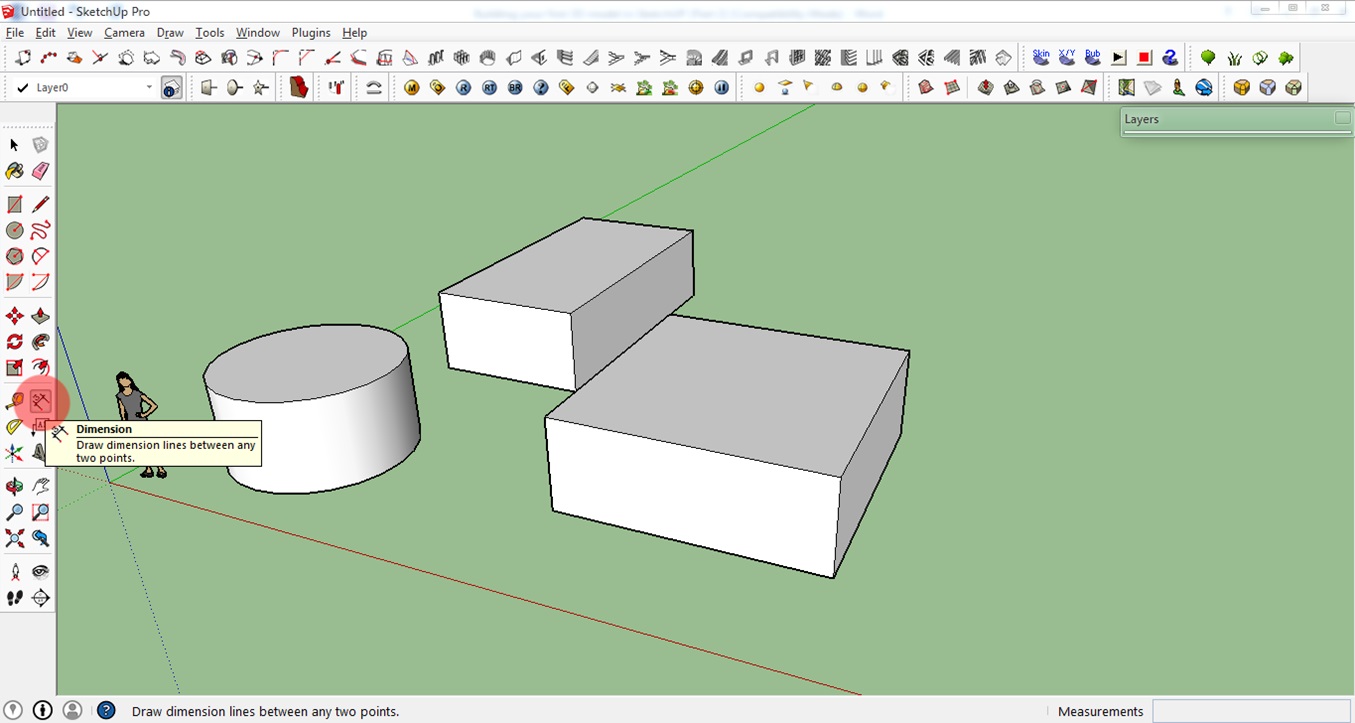
This tool allows you to bank check the dimensions of your model.
ane. To use this tool, simply click the Dimension icon on the toolbar
2. Adjacent: either click the starting point and then the end point of the line you want to measure. Or simply click the line. Y'all volition so see the length of your line or object

You can also apply this Tape Measure Tool to measure distances more freely and the Protractor Tool to check unlike angles. The best way to learn how to use these tools is by playing around with them. You can see the results of the Tape Measure Tool and the Protractor Tool in the lower right corner (see screenshot below).
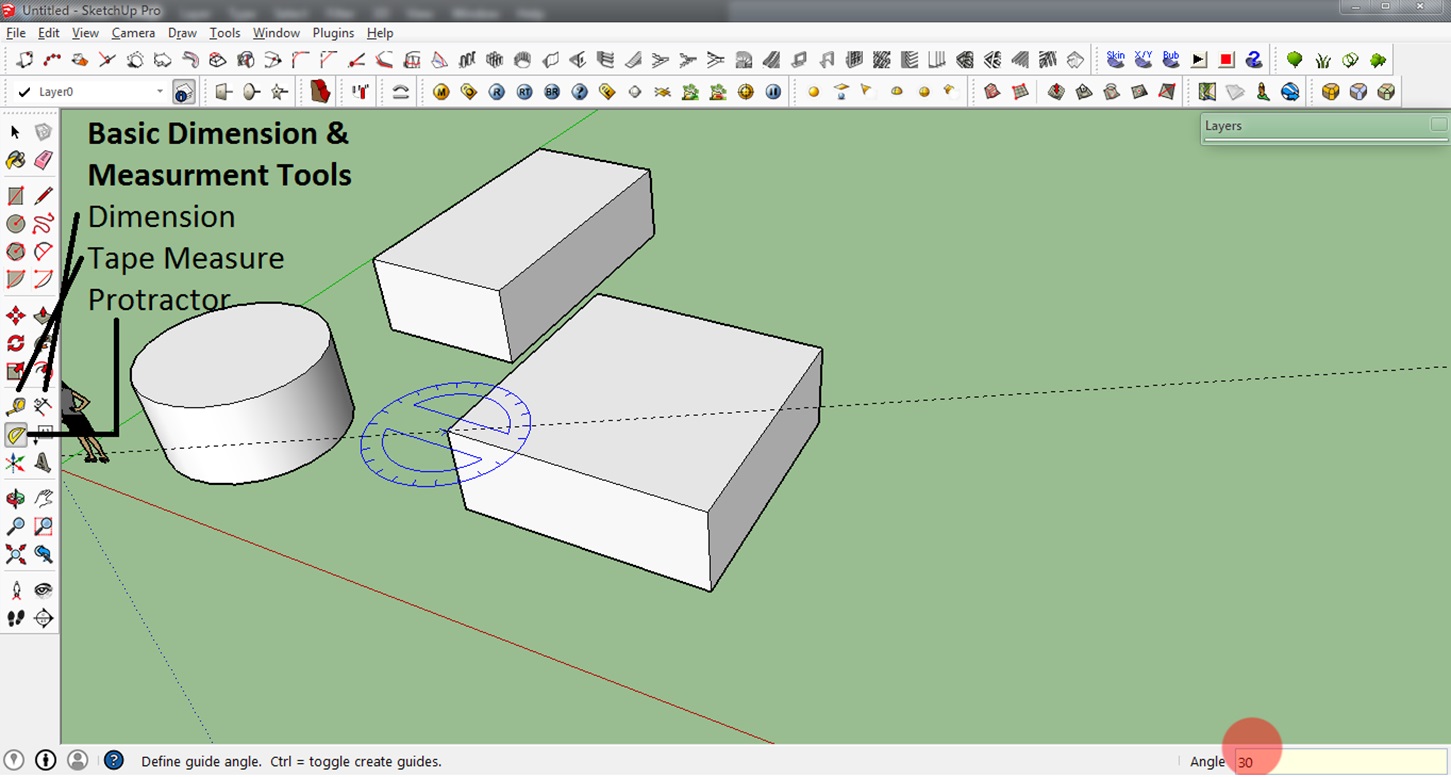
Stride ten: Moving and Maneuvering Objects
This tool is very easy to apply:
1. First select the object you want to move. Exercise this by clicking on the Select tool and 'drawing' a selection net around your object
2. Click the Move tool or simply press One thousand on your keyboard
3. Click the selected object and drag it. Simply click again when y'all accomplish the desired location
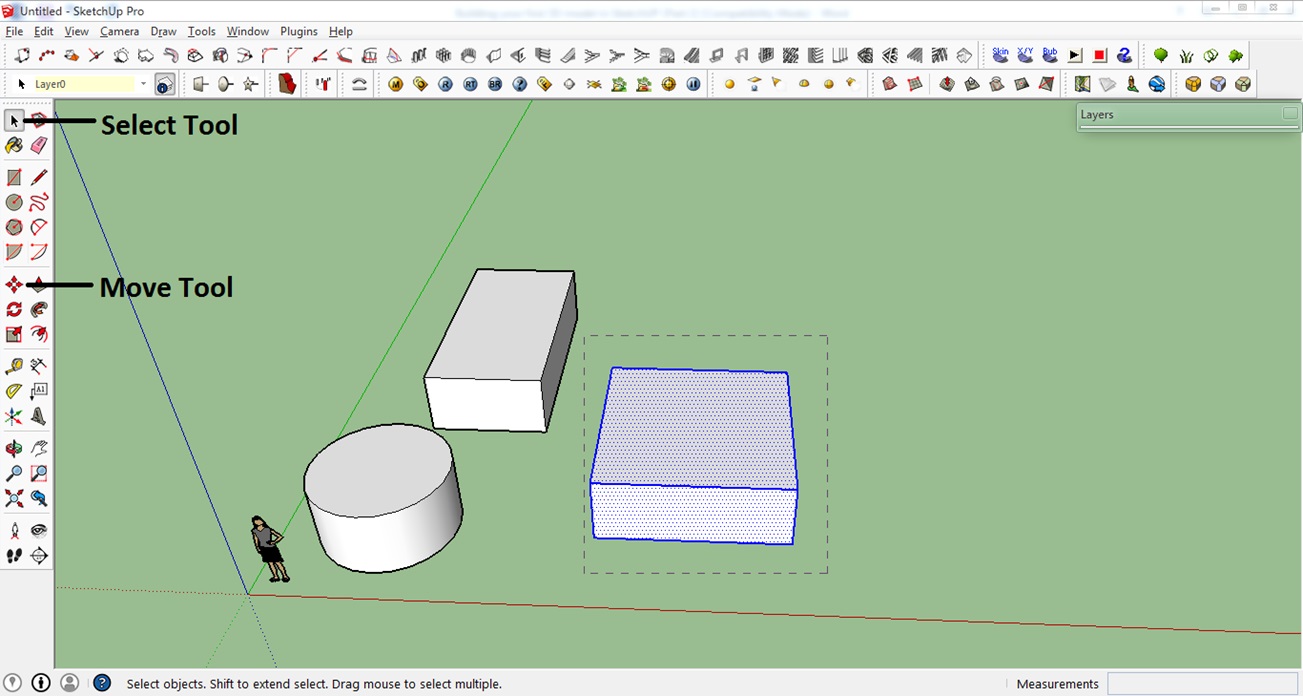
Step 11: Creating Copies of Your Object
1. To create a copy of your object, select it again (as seen simply to a higher place)
2. Press Ctrl on your keyboard to create a copy of the model
three. Left-click again to place the copied model in the desired location
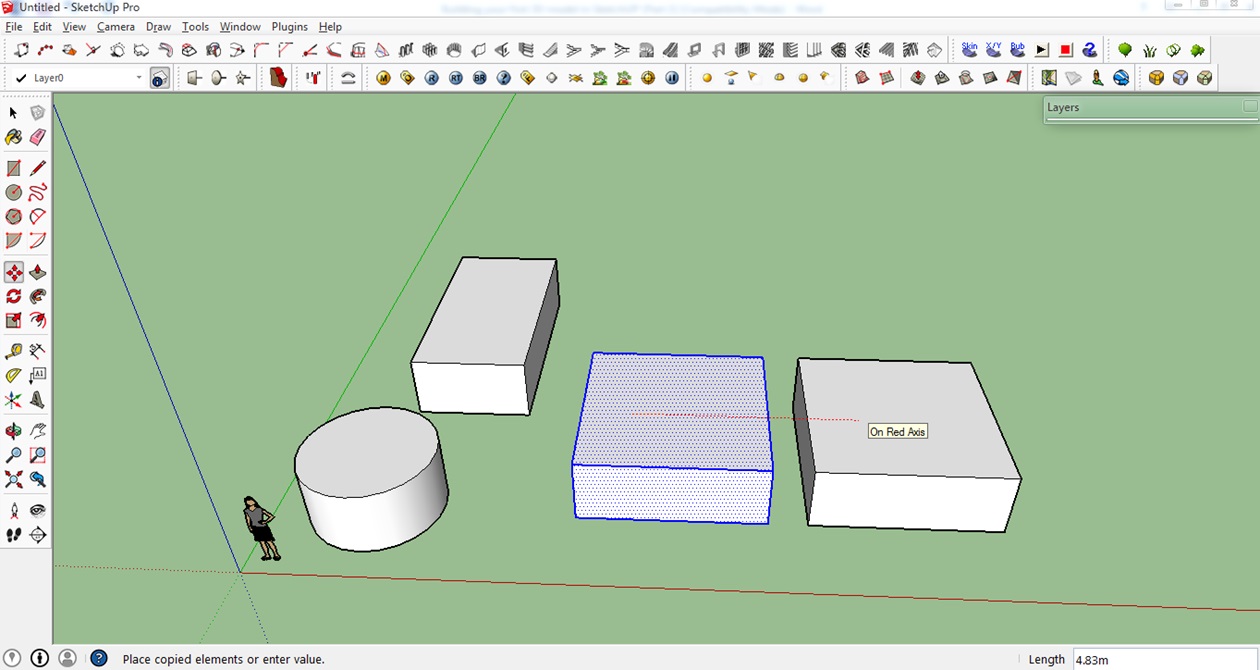
Pace 12: Erase Tool
This tool works like a basic eraser: information technology erases lines or planes you have created.
1. First click on the Eraser tool on the toolbar
two. In one case the eraser icon appears, click on the lines you lot want to erase
(you can also select a line with the Select tool so hit the delete button)
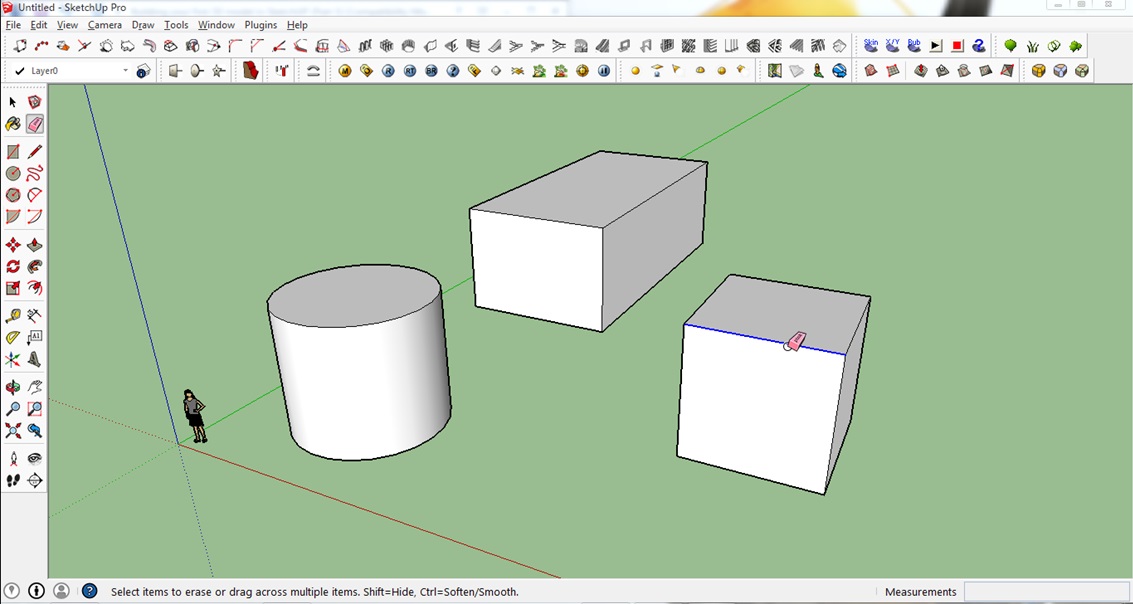
Step thirteen: Text
The second text tool allows you to calculate base of operations areas of planes and to place labels. In the picture below it was used to label the object equally a 'cube'. The pointer indicates which object was labeled.
The 3D text tool actually creates the text equally a 3D object that is function of your pattern. As always, it makes sense to just play effectually with these two tools.
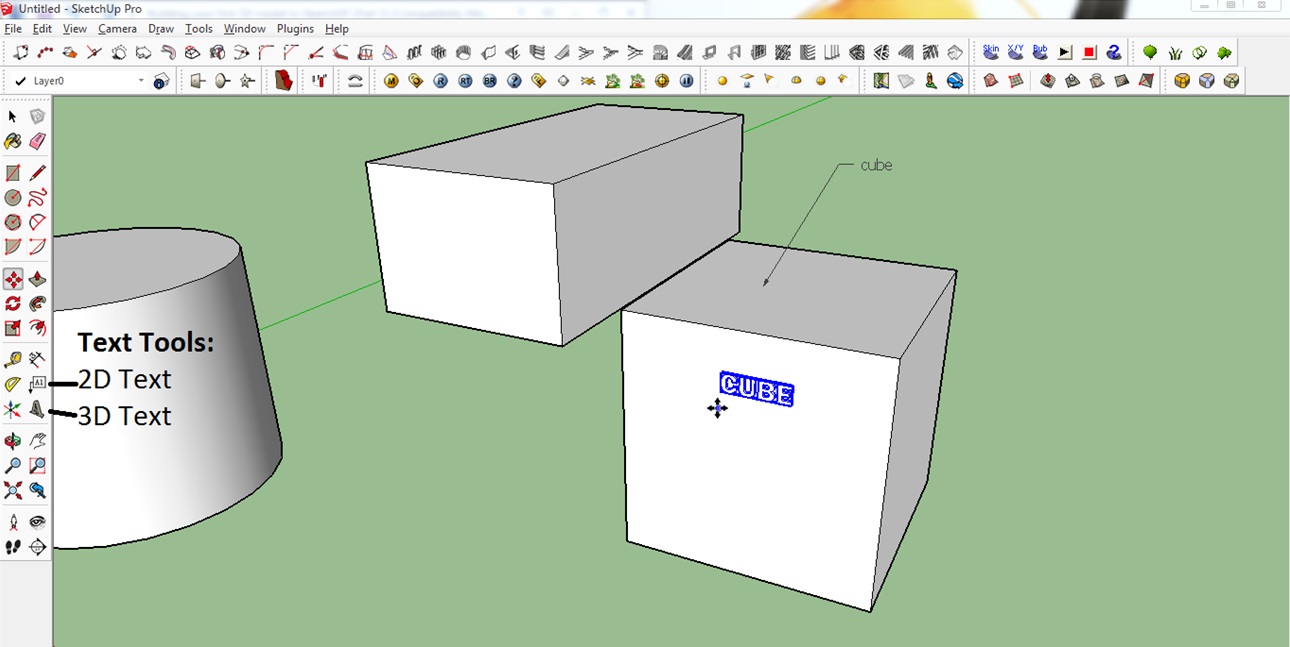
Step fourteen: Basic Cut
This tool allows you to cut or eliminate a section of your model. To show you lot how to use this tool, we used the cylinder.
1. Click on the Penciltool in the toolbar to depict a line (we used this tool at the beginning of the tutorial)
two. For this tutorial, make a line on iii points of the surface of the cylinder. Mark the first at whatever bespeak on the edge of the top surface of the cylinder. 2nd, make a point in the middle and third, make a point that aligns to the cherry-red centrality
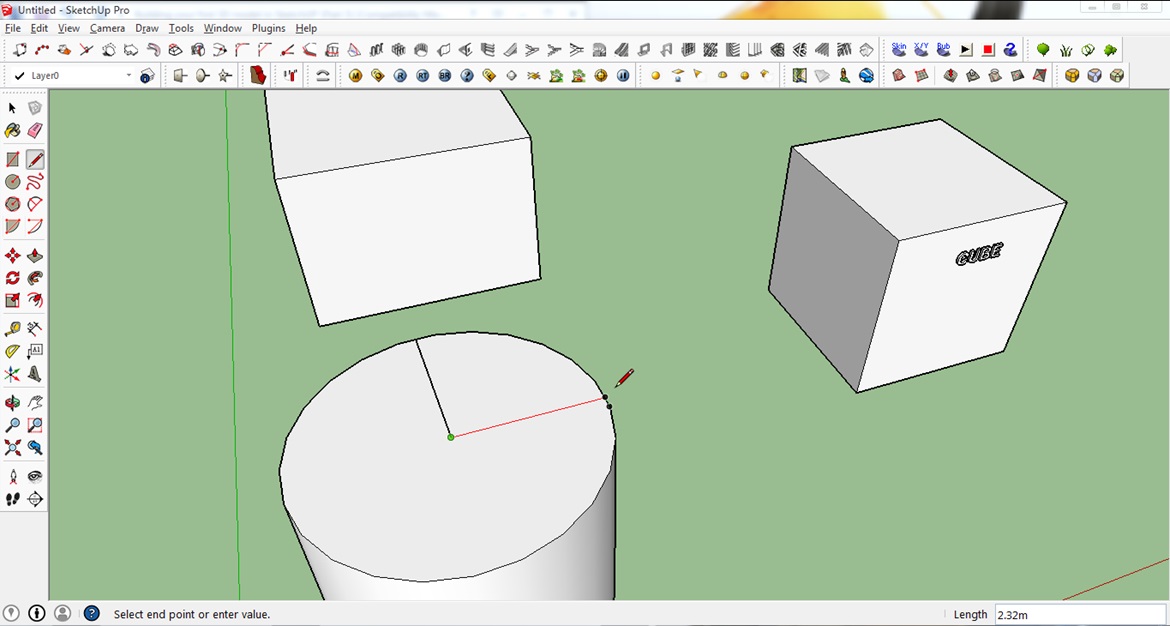
3. Click on the Push/Pull tool on the toolbar
4. Click on one half of the superlative surface of the cylinder and push it downwards to create the cut and click to finalize
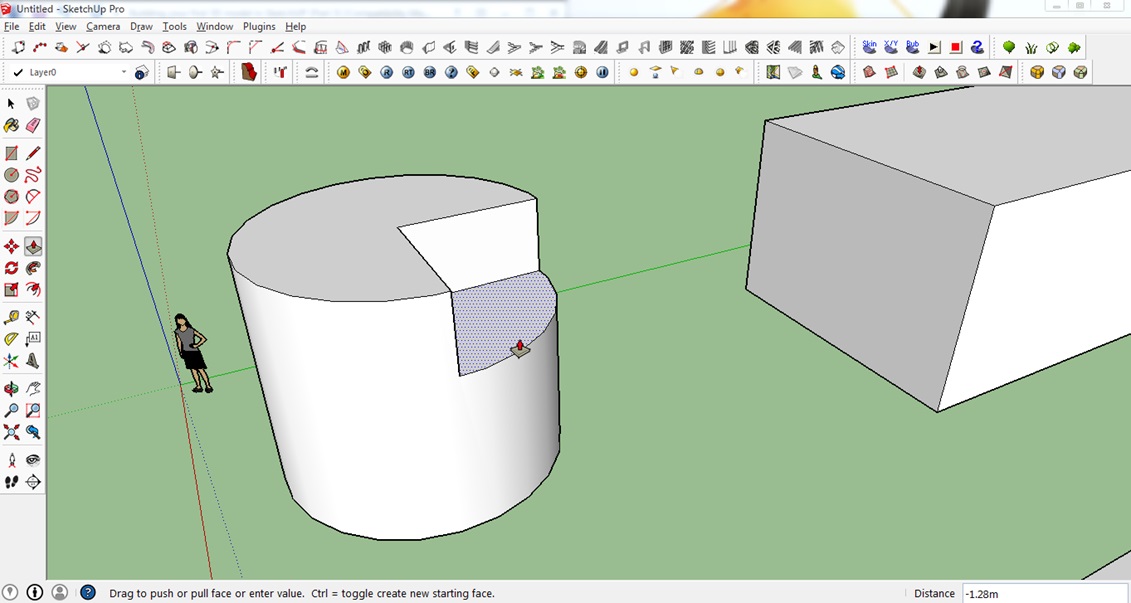
What a dainty, make clean cut! Play around with this tool some more to discover all its functionalities.
Step 15: Drawing an Arc
As well lines, let's try to draw with the Arc tool. It allows you to draw a curve. After selecting the tool, click on one of the corner points of a cube. Then click somewhere on one of its superlative axes and depict an arc. Sounds complicated? Information technology'southward easy once you endeavor it!
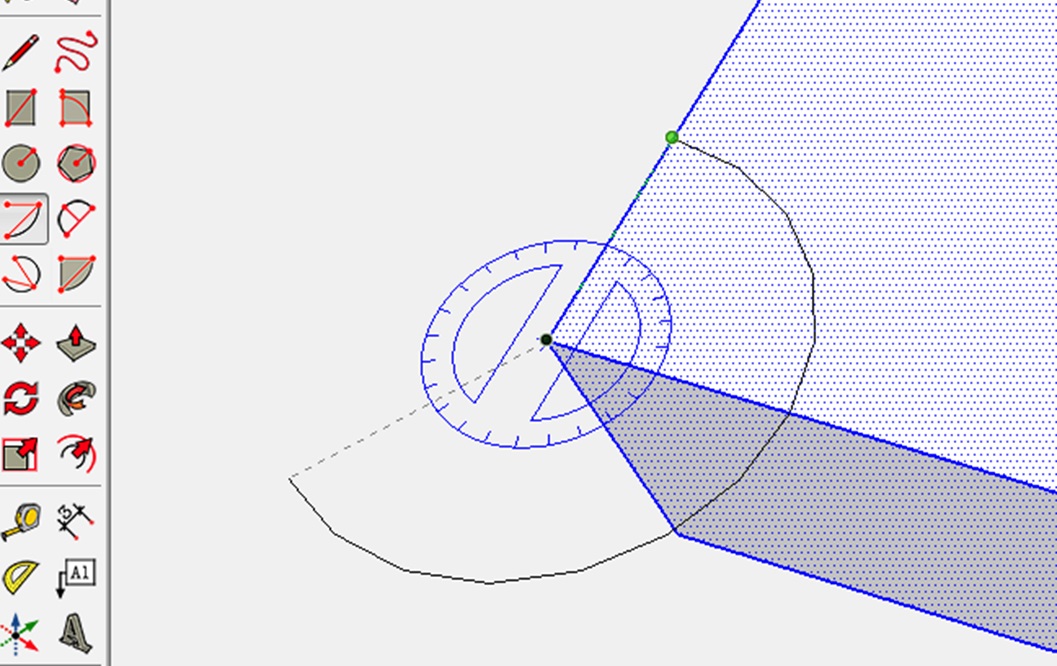
After having drawn your arc, employ the Pull/Push tool to cutting this function off.
Step 16: Scaling and Stretching
This tool allows y'all to adjust your model accordingly or to the desired scale.
To utilise this tool, simply select your model first and click on the Calibration tool on the correct or press S on your keyboard. This volition bear witness you the dissimilar scaling points you can use. Y'all can scale and stretch the object by clicking on the green dots that appear.
If y'all want to calibration our model up or downwardly while maintaining the ratio and proportion of our rectangular box (this is called uniform scaling) you need to click on one of the 8 corner points of the rectangular box.
You volition see the value of your scaling in the lower correct corner of the window. A value of 0.50 means y'all volition be scaling your model down to fifty%.

Pace 17: Rotating
This feature is very useful when you experience orientation issues. This is when you take your model facing the reverse/wrong direction.
i. Starting time select the model you want to rotate and select the Rotate tool or press Q on your keyboard
ii. Click on the centre of the acme surface of the rectangular box to ready your axis. Extend your cursor towards the light-green or red centrality to select the baseline of your rotation
three. Rotate the model to the desired direction or just input an bending value. In this instance, nosotros entered 30°

Y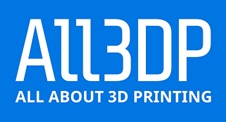 ou now know 17 important tools to get started! It'due south time to create your showtime 3D model in SketchUp yourself, and we hope you enjoyed this tutorial by All3DP's SketchUp skilful Mich Judelag. If yous want to stay up to date with all things related to 3D printing, brand certain to check out All3DP's website here.
ou now know 17 important tools to get started! It'due south time to create your showtime 3D model in SketchUp yourself, and we hope you enjoyed this tutorial by All3DP's SketchUp skilful Mich Judelag. If yous want to stay up to date with all things related to 3D printing, brand certain to check out All3DP's website here.
Did you lot already create a 3D model in SketchUp and desire to go far 3D printable? This requires some extra steps which y'all will learn in this tutorial . One time you know how to model in SketchUp and how to make your 3D model printable, you could create an amazing object such as Kurt Plagge'south ' Articulated Cube ' .
Are you more interested in simple 3D modeling software for sculpting organic objects? Then our SculptGL and Meshmixer tutorials might come in handy.
houstonthounfor1944.blogspot.com
Source: https://i.materialise.com/blog/en/first-3d-model-in-sketchup-tutorial/
Post a Comment for "sketchup 2d drawing to 3d"